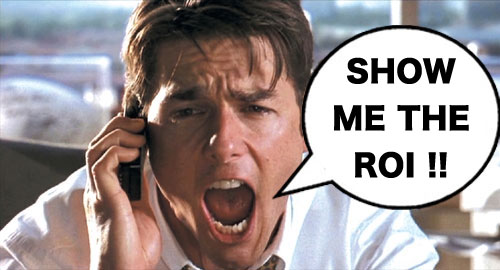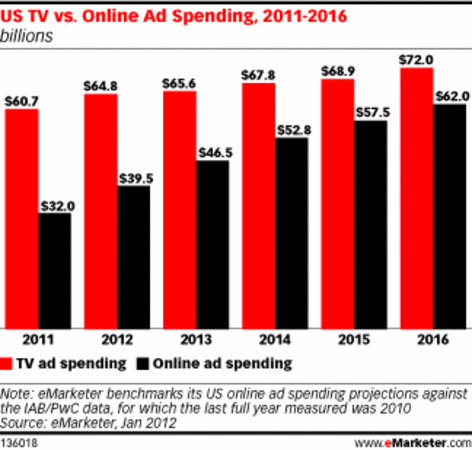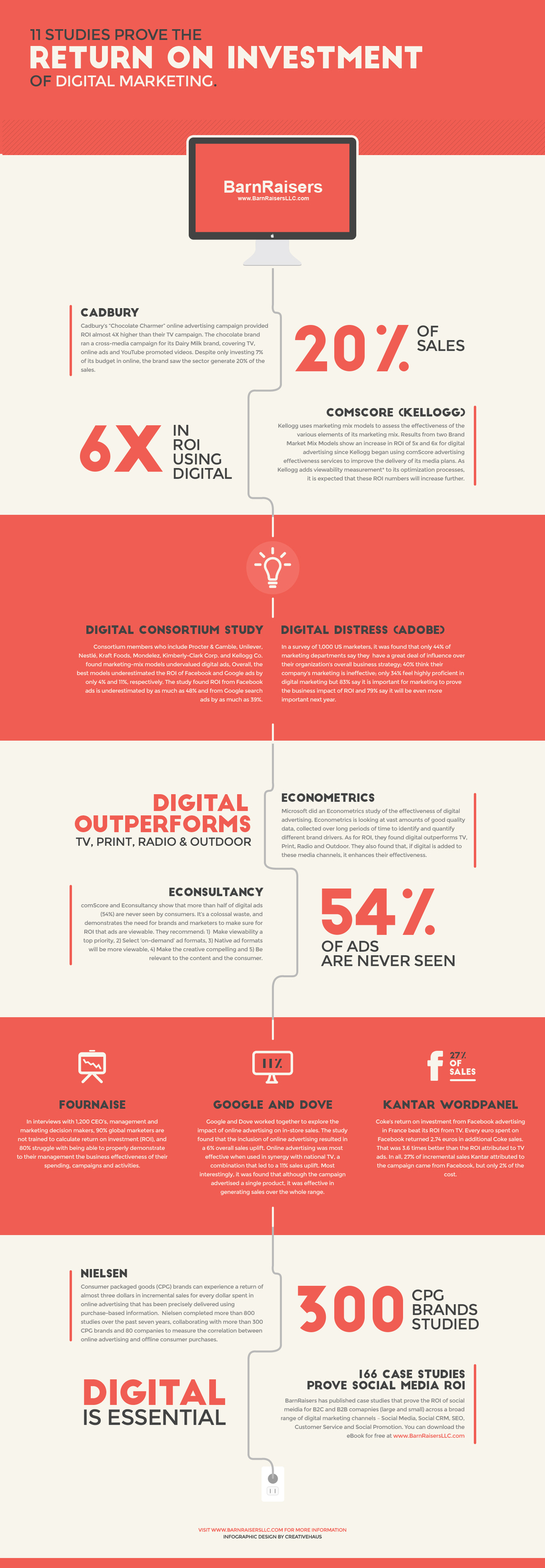TV and Digital are the two media channels that now receive the most ad spending. They are the only two media channels where ad spending is increasing as opposed to Print, Radio and Outdoor where it is decreasing. If current trends continue, Digital is expected to overtake TV by 2018.
Marketers spend more in Digital but many companies ask: Show me the ROI!
To better understand Digital Marketing ROI and this trend, we recently published 11 Studies Prove the ROI of Digital Marketing. Below is an Infographic of our findings from Piktochart, a company that offers an all-in-one online infographic application where anyone can create custom infographics, banners, reports and presentations online utilizing an easy interface that everyone can use.
11 studies is a significant number. If you need more convincing, here are 6 more studies that prove Digital Marketing ROI.
- ADAGE: (WHERE DO WE SPENT OUR TIME?) At 3.9 hours daily, TV viewing remains the most time-consuming media activity, followed closely by going on the internet with a computer, not for work, at 3.8 hours. 95% of respondents go online at home; plus, 57% go online using their mobile phone, and 16% do so for at least 3 hours daily. If computer and mobile are added for internet usage, consumers now spend more of their leisure time on the internet than TV,
- HARVARD BUSINESS REVIEW (HOW DO WE BUY?): In Branding in the Digital Age, You’re Spending Your Money in All the Wrong Places, HBR reports the internet has changed the way we buy: Once, a shopper would systematically winnow his brand choices to arrive at a final selection. Now, relying heavily on digital interactions, he or she evaluates a shifting array of options and remains engaged with the brand through social media after a purchase. Consumers today connect with brands in fundamentally new ways through the internet and social channels.
- INTERACTIVE ADVERTISING BUREAU (IAB) (WHAT CAN WE MEASURE?): The IAB, 4 A’s and ANA concluded that brand engagement was not a single event; rather, it was a continuum of activities that were cognitive, behavior and emotional. They then demonstrated by detailing every possible touch point of the consumer journey how the engagement “journey” could be measured for digital through survey, eye tracking, web analytics, social listening and social analytics more effectively than any other media channel.
- MCKINSEY (WHY DOES IT WORK?): McKinsey analyzed 24 customer touch points for more than 9,000 new car buyers to better understand which touch points drive customers’ premium perceptions and willingness to pay. Among their conclusions: 1) Digital channels dominate the purchasing “journey,” 2) digital customers demand seamless integration, 3) digital products secure loyalty and 4) digital sales are bigger than expected.
- SEORCHERS (HOW MUCH DOES IT COST?): To reach 1,000 viewers, it costs between $1-$3 for Online (Search) and $5-$10 for Online (Display). This compares to $10 for Cable TV, $24-$30 for Prime Time TV, $40 for Radio and $100 for Magazine. Plus, 90% of all purchase decisions begin online.
- SYNCAPSE (WHAT IS THE ROI OF WORD OF MOUTH?): Sharing, comments, Likes, reviews and ratings are prevalent on the internet. Do they influence buying behavior? What is their value? Syncapse has been measuring word of mouth since 2010 to understand the value of a Facebook Fan. They measure Fans for over 20 major brands including BMW, Coca-Cola, Disney, McDonald’s, Starbucks and Walmart. In the latest year (2013), the average value of a Brand Fan increased 28% to $174.17. This is because Facebook Brand Fans are: 1) 85% more likely to advocate their brand versus 60% for non-Fan users, 2) Spend 42% more in respective categories than non-Fans, despite no income difference and 3) 11% more likely to continue using their brands than non-fan users.
Newer media channels always have more to prove. If your company requires proof points, 17 studies that cover a wide range of industries and media properties should satisfy those who need convincing.
Do these studies prove Digital Marketing ROI to you?







